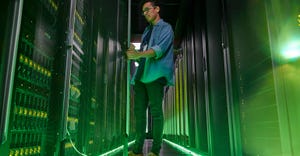Key Trends and Technologies Impacting Data Centers in 2024 and Beyond
Omdia Research Director Vladimir Galabov breaks down the latest global data center trends and his expectations for the industry in 2024.
March 7, 2024

There are many trends and technologies affecting data centers on a global scale. These include pressure to achieve sustainability, rising rack densities, coping with demanding AI workloads, the need for more data centers and the implementation of advanced cooling. Vladimir Galabov, Research Director of Cloud and Data Center at Omdia, provided an overview of these subjects during a recent AFCOM webinar titled Leap Year Insights from Omdia’s Research Director.
Data Centers: A Force for Good
Galabov began by explaining how data centers are a “force for good,” but we need to do a better job of letting the world know. So much attention is devoted to the high power and water consumption of data centers. While sustainability initiatives can and should be given priority, there is another side to the story that is usually missed: The industry has positively impacted worldwide energy usage.
“We don’t do enough to capture and promote the efficiency gains that are afforded by the technology industry in making the overall economy less energy-intensive,” said Galabov. “The paper industry, for example, is one of the most energy-intensive; technology has certainly made a huge difference by reducing reliance on paper.”
He cited a Lawrence Berkeley Laboratory study indicating that even greater use of technology can reduce the growth of carbon emissions by one third. Another study by the University of Tokyo found that Japan could decrease its carbon dioxide emissions by 40% or more through IT. Similarly, the American Council for an Energy Efficient Economy estimated that for every kilowatt of energy consumed by the IT sector, 10 are saved in other sectors.
“Look at energy use in the United States in the 1970s and project that same level of energy intensity forward; we would be consuming a significantly higher amount of energy today if it wasn’t for data centers,” said Galabov.
How AI Impacts Energy Consumption
The advent of generative AI means there are going to be more and more questions asked of the data center industry about our responsibility from a power consumption perspective. But what needs to be understood, Galabov says, is that between 2008 and 2020 – despite a vast upsurge in worldwide computing and internet usage – data center’s share of global electricity usage remained about 1%. Such efforts emphasize the massive strides made in efficiency centered around power usage effectiveness (PUE). Case in point: more than 13,000 bank branches have been closed in the U.S. as end users moved to digital banking.

Current US energy consumption is only half of what it would have been if levels of energy efficiency and energy productivity had remained the same.
However, the growth of AI and adoption of GPUs is about to change the energy usage equation. NVIDIA projections for 2024 show more than double the shipments of data center GPUs, compared to previous numbers. That’s going to add a lot to power demands.
“As more power is dedicated to AI, the share of worldwide electricity in the data center is rising to about 2% within a couple of years,” said Galabov.
Data Center Construction Trends
Beyond increased power consumption, Omdia expects the pace of data center construction to slow in mature locations such as the U.S., EU and China as abundant capacity already exists. In emerging locations, however, the pace will ramp up. Africa, Latin America, the Middle East, India, Thailand and Vietnam will all see more data centers, Galabov said. Hence, U.S. construction has dropped from 49% of the worldwide total in 2017 to 35% today.
“Ethiopia and Namibia plan to double data center capacity each year, though they are starting from a relatively low number,” said Galabov. “Another factor to understand is that ongoing data sovereignty initiatives will impact where data is stored and where new data centers are most needed.”
In addition to more data centers, the world will also see rack density increasing for the next several years. From 7 kW per rack in 2021, we have already arrived at average rack densities of 12 kW, according to Omdia. Expect that upward trajectory to continue with 20 kW averages likely by 2030.
Efficiency and Sustainability
With such an upsurge in power usage and density forecast for the coming years, the industry must double down on efficiency and sustainability. Galabov said we are about to experience a new wave of data center optimization with a focus on reduction of the IT footprint – consolidation of equipment, fewer mechanical components, improvements in power conversion, and the advent of AI-powered DCIM and management systems for the data center.
“There is an opportunity for DCIM to become a centralized automation tool that can operate across data centers and all the way to the edge,” said Galabov. “By enriching DCIM with AI, we can minimize the impact of staff shortages and evolve ways to further improve efficiency and sustainability, both at the IT and the physical infrastructure level.”
According to the AFCOM State of the Data Center 2024 survey, more than half of all data centers plan to implement solar and more than 25% are adding wind. Others are looking at nuclear, hydrogen, geothermal and battery energy storage systems (BESS). This can lower the cost of energy overall by moving away from reliance on a utility.
The Data Center Becomes an 'AI Factory'
AI is exerting its influence on just about every area of life – including the data center. One in five people in the United States had used generative AI. Many data centers are in the planning stages in devising long-term AI strategies.
“Step one is to turn the data center from a compute and storage factory into an AI factory,” said Galabov.
That entails accommodating higher density and gaining further efficiencies such as improving airflow management and containment. Expect liquid cooling to evolve rapidly, too, with low-cost options appearing, he added. For example, a Chinese company named KeenCool has developed a single-phase liquid that is selling at 6% of the cost of that offered currently by others.
“As liquid cooling becomes more democratized, we're going to see more competition across the direct-to-chip and immersion cooling markets,” said Galabov. “Immersion cooling prices should come down considerably.”
Further, expect changes related to AC to DC power conversion. NVIDIA reports, for example, that around 10% of power is being lost in these conversions in its DGX Server. Systems are being developed that need fewer conversions from AC to DC within the data center. Some data centers are also seeking greater efficiencies through consolidation. One facility worked with Dell, for example, and decreased its IT footprint by 90% and energy bills by 75%.
“The data center of the future may end up having fewer racks that are of higher density,” said Galabov. “We have been reducing PUE successfully through more efficient cooling and power infrastructure, but there is still room to reduce the power conversion to address unnecessary power loss while improving the utilization of IT equipment.”
Old vs. New Data Centers
Galabov believes that traditional data centers should be regarded as a major success story. Through virtualization, containerization, software-defined architectures, the cloud and IT consolidation, they have achieved big gains in efficiency and performance. Now, we are entering into a new era of utilization for the data center via areas such as application optimization and improvements in processing power and design. Google is a good example: For media processing, it has deployed highly optimized servers, where they're now replacing five old servers running YouTube with one of new one containing low-power ASICs.
“New data centers will optimize their physical infrastructure for AI,” said Galabov. “Liquid cooling is already being optimized for AI and we will soon see centralized, AI-driven energy management systems.”
Visit the AFCOM website to watch the full webinar.
Read more about:
OmdiaAbout the Author
You May Also Like









